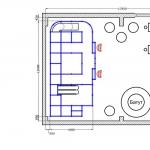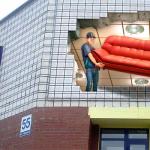Outdoor advertising trends. Trends in outdoor advertising
The advertising market is a system of economic forms and mechanisms associated with the formation and functioning of advertisers, advertising agencies, media holdings, intermediaries in advertising, producing advertising goods and selling them as a service through advertising media for a consumer audience in accordance with the goals and objectives of marketing.
The advertising market is a sphere of advertising activity, a system of economic relations between the advertiser and consumers of the service and between advertising intermediaries (advertising channels) and advertisers. In this case, the main form of connections in the first case is purchase and sale, and in the second case - competition.
Design developments, the emergence and development of new technologies in outdoor advertising are among the most important strategic qualities that determine the effectiveness of using this type of advertising.
The design of outdoor advertising concentrates a complex of phenomena related to the economic life of society, culture in general, as well as art. Its design and information component are developing simultaneously with the improvement of technology and the emergence of new, previously unused types of media and materials. When developing the design of outdoor advertising, design solutions are more focused on more understandable, intelligible and attractive information to the consumer about the advertised product/service.
Innovations in outdoor advertising of the 21st century
Thus, one of the frequently used and most accessible types of outdoor advertising is a poster - an easel form of graphic art, which is a large sheet with a catchy image and short text, having informational, advertising, propaganda or educational purposes, the main condition for the existence of which is a demonstrative plane (stand , showcase, wall).
The poster, which has the driving force of an advertising campaign, simultaneously acquires new significance - it becomes flexible and receptive to all new technologies. The latest technologies of our time make it possible for a poster to emerge from a static state. This is facilitated by changes associated with the use of new digital technologies and materials.
This trend is gaining momentum, the essence of which is the search for new artistic forms that have a flexible structure and express the global meaning of social transformations.
Thus, the appearance of LEDs, neon, plastics, various films, various types of high-quality printed products became a breakthrough in technological terms and gave outdoor advertising new artistic, technical and information technology capabilities, significantly expanding their use in design developments.
The use of LEDs in primary colors (green, red, blue) made it possible to obtain sign colors of virtually any shade, as well as to construct displays from them that display full-color graphics and animation. High light output, reliability, ease of installation, no operating costs, low power consumption, dynamics of information and color changes have brought these technologies to the forefront. A wide variety of possibilities allows us to produce outdoor advertising that not only has great artistic value, but also carries a significant information load. What makes this type of outdoor advertising one of the most effective, informative and in demand is its catchiness, the possibility of varied graphic design, and visual accessibility.
Neon outdoor advertising, which has existed en masse since the middle of the last century, is currently experiencing significant technological changes. New materials and technologies have expanded the production of this type of advertising, increased the information, artistic, technical and aesthetic capabilities of the advertising product produced on their basis, given designers new and effective ways and means of designing outdoor advertising, and made it reliable and durable in use.
For example, the use of new types of plastic can maximally satisfy the requirements for materials for advertising production. The determining factors are broad criteria for choosing color, the degree of light transmission of the material, surface quality, as well as the ability to give the selected material the required shape.
With the help of innovative technologies, the manufacturer strives to provide a qualitatively new, different from previously used means of influence on the potential consumer (the object of advertising), thereby prompting him to perform a certain action, namely the purchase of the advertised product. Innovative processes occurring in society, various innovations and the practice of their application, as well as dissemination, are one of the main and most important problems of the present time.
Modern methods of transmitting messages (channels, means, media) are extremely diverse (from classic posters, billboards, illuminated signs to modern electronic boards, screens and laser systems). The increasing complexity of economic relationships in society, the scale of production, and urbanization entail the development of new technologies that cannot do without advertising support, which is a powerful incentive for the development of information structures.
Currently, advertising media themselves are no longer enough, despite their huge variety. The new trends in question are related to the fact that the mass consumer society created by the industrial revolution is increasingly differentiated, turning into a “demassified society” - a trend in which the mass market breaks up into ever-multiplying, changing mini-markets requiring an ever-expanding range models, types, sizes, colors and compliance with various consumer requirements. It is one of the driving forces aimed at innovative changes in advertising itself and in its design.
Design is the tool that allows outdoor advertising to acquire new qualities and adapt to the placement environment. And only new innovative design technologies will allow outdoor advertising, organically woven into the spatial, socio-psychological environment of placement, not to lose its position to other rapidly developing types of advertising.
The task of outdoor advertising when using innovative technologies is to maximally smooth out the differences between the new image and established local spatial canons and try to fit into this environment, and possibly complement and qualitatively improve its content.
In this regard, it should be pointed out that the factor of preserving the traditional matrix of what was previously created is facilitated by the years-verified compliance of the recreated outdoor advertising with the style, aesthetics, image and character of the placement environment, design aesthetics, cultural and visual-graphic components.
Each time period, especially in urban planning, is characterized by the presence of a unique, established artistic direction, sometimes called the style of the era; often it represents a completely completed and established architectural and artistic norm, expressing a set of aesthetic ideas and rules established in this time period.
Finding a balance between the innovative component of outdoor advertising and the need to maintain the aesthetics and style of the advertising environment is another most important task in the field of advertising.
According to Nielsen research, outdoor advertising showed solid growth last year. Big data, digital strategies, targeting and audience analytics will continue to transform UN advertising, causing advertisers to change their ad planning and creative approach. As new data collection methods and digital channel integration become available online, they will continue to increase the importance of outdoor advertising, making it an integral part of the media plan.
The UN will continue to implement digital marketing strategies
Marketers are increasingly paying attention to how UN advertising and digital media intersect. Bringing these two components together as part of a comprehensive strategy will help strengthen the position of each of them. Analysis of digital media will help in planning outdoor advertising, and that, in turn, through geofencing and other interactive technologies will be able to attract more target audience to the advertiser’s digital environment.
Integrating digital marketing strategies into the UN will provide an opportunity to streamline consumer data. Using the smartphone, demographic and behavioral data will be mined and aggregated to provide advertisers with better performance. This data will allow for more active feedback because the virtual message will be better tailored to the consumer's daily habits.
Geofencing and other digital technologies used in outdoor advertising provide real-time data that can be quickly analyzed and reused in future campaigns. Thanks to website geoprocessing, consumer information is generated at the point of purchase for better marketing.
Combined with geolocal technologies, outdoor advertising will become a key component of a personalized advertising strategy, reaching target audiences in the right place at the right time. When we are interested in a product or service, we actively search for it on the device that is most convenient for us - most often a smartphone. According to Google, 76% of people who search for a location on their smartphone visit that location during the day. Possessing a localization character, the UN will help manage the behavior of Central Asia.
Every day we pass by outdoor advertising that provides a personal touchpoint, creates interest and helps drive digital interactions. Notably, Nielsen’s latest “Ads Driving Online Activity 2017” report states: “While OOH advertising makes up 26% of the top searches generated by TV, radio, print and OOH combined, it accounts for just 7% of the total amount of advertising expenses.
The “phygital” (i.e., connecting the physical and digital world) aspect of the combination strategy is of great importance. Personalizing the message generates immediate direct response through search, sending links to friends, etc., similar to the immediate response mechanism of digital advertising. The advantage for the consumer who is constantly on the move is personalized advertising. While this type of advertising is still in its infancy, it will continue to evolve and become more unique and data more relevant.
To be continued
The rapidly growing outdoor advertising market is becoming more technologically advanced. Now, ordinary billboards and signs will not surprise anyone - advertising must be original, unusual, surprising every passerby. To present information, each advertising agency strives to create a structure that will become a kind of city landmark. It will be noticed not only by passers-by, but also by the media, which means that not only the advertising will be effective, but its creator will also become famous.
From September 26 to 29, 2017, the Expocentre Fairgrounds in Moscow will host the 25th international specialized exhibition "Advertising 2017", which will present many new products and modern technologies in the field of creating and positioning advertising.
3D technologies in outdoor advertising
The creation of multi-level structures has become a real breakthrough in the advertising business.

Agree, embossed, expressive billboards, on which life-size objects are displayed instead of photographs, can attract much more attention.
When creating 3D effects the following is used:
- computer graphics;
- projection advertising;
- holographic installations;
- optical illusions;
- design and artistic developments.
Each type can safely be called art, because to create such advertising you need to spend more than one hour on implementation, and even more on developing the idea.

It is very beneficial to support it with the same technologies, designing, for example:
- shop windows;
- foyers and lobbies of entertainment, cultural, shopping centers;
- signs for shops and offices, restaurants and cafes;
- sidewalks, driveways and floors in crowded, high-traffic areas.
Even souvenirs are created with interactive elements or 3D effects. Three-dimensional images sometimes seem unreal, they are so skillfully executed.
The process of creating 3D designs is quite complicated, so not all advertisers want to use it. However, if you want to draw attention to your product or organization, then of course, this way of presenting information will definitely be noticed.
Floor advertising
Another expressive and memorable way of informing is floor advertising, which is increasingly used in large cities, both outside and indoors.

Large images placed right under the feet of passers-by simply cannot go unnoticed; it is somehow awkward to step on them, especially if they depict depressions, hills, or objects that can be tripped over.
And these are not only footprints or signs that lead in the right direction. With the help of 3D graphics, it has become possible to draw so naturally that it seems as if there is a cliff, abyss or other insurmountable obstacle ahead. Such installations evoke delight and surprise; people take photographs against their background, which means that advertising is distributed through all possible channels.



The floor of the elevator was also designed to look like the entrance to a swimming pool, causing all visitors to involuntarily pause and pull their leg away in fear. Needless to say, such advertising is remembered for a long time, it is discussed, shared on social networks.
LED advertising
- extend the service life of any structure:
- significantly save energy costs;
- the abundance of shades of LED strips allows you to convey the smallest details of images;
- such structures are not afraid of voltage surges and do not need to be replaced for many months;
- do not fade or fade in the sun like paper banners or paper;
- work at humidity up to 90%;
- do not fail at temperatures from -45 to +50 degrees C.

Electronic screens broadcast not only text information, but also videos, advertising films, product presentations, animated images, and tickers.
Video screens are often used to show sports competitions and holiday events that attract large numbers of spectators. In the intervals between shows, advertising blocks are broadcast.
Another type of projection broadcast is laser advertising. Watch a video of what the show looks like:
Projection advertising
A great way to use empty walls of high-rise buildings is to broadcast advertisements using a projector.

Any flat surface can be used to display advertising messages, videos, informational texts or images.
This technology is very easy to install. Using a projector, you can transmit messages to building facades and any vertical surfaces. The scale of the projection is not limited by the size of the billboard, which means that the display will be clear, noticeable from a distance, and impressive. Advantages of projection advertising:
- the ability to display in places that are inaccessible to conventional types of advertising;
- the façade of the building is not actually involved, which means it will not be destroyed by moisture accumulation or the weight of the advertising structure;
- Although the design requires permission from the owner of the building, it is much easier to obtain than if it is necessary to install a heavy metal frame for mounting a billboard;
- advertising messages can be changed as often as the advertiser wants.
See what a showcase equipped with a projector might look like:
Methods for installing projection equipment
There are two ways to mount the projector:
- Stationary, in which it is necessary to install a protective installation to prevent moisture and other atmospheric precipitation from entering the projector.
- A truck with a gas generator is used to supply electricity to the projector.
International exhibition "Advertising 2017"
All types of new technological developments in the field of advertising will be presented at the international exhibition in September 2017 at Krasnaya Presnya at the Expocentre Fairgrounds.

Specialists not only from our country, but also representatives of the advertising business from near and far abroad countries are invited here.
Will come to the exhibition:
- representatives of advertising and marketing agencies;
- manufacturers and creators of new products in the field of advertising;
- suppliers of consumables and equipment;
- representatives of printing companies and printing houses;
- journalists, correspondents, television cameramen and other media representatives;
- customers and advertisers interested in placing their advertising messages using new technologies.
Exhibition theme
The following types of advertising areas will be presented at the exhibition:
- services in the development, creation, design and promotion of advertising;
- visual technologies;
- POS materials;
- souvenir products.
Every day the exhibition will take place:
- presentations of new products in the field of advertising;
- discussion of pressing issues in the field of advertising business;
- seminars and conferences;
- master classes on the creation and operation of new types of advertising media;
- displays of the latest developments in the field of advertising and marketing.
Each participant will be able to find partners, suppliers of new equipment, and customers for their products. It is not for nothing that this event is called created by professionals for professionals.
Andrey Amiryan tells how market players will remember the outgoing year and what trends will affect the development of the industry.
To bookmarks
Internet advertising overtook television for the first time
In the first quarter of 2017, experts estimated the growth of the online advertising market at 25-30%. According to AKAR, in the third quarter of 2017, the volume of the online advertising market for the first time surpassed the classic TV segment and amounted to 41 billion rubles against 36.2–36.7 billion rubles. Over the nine months of this year, the share of television amounted to 116-117 billion rubles, and the Internet - 115-116 billion rubles in the total advertising budgets.
This is a historic event for the online advertising industry. Over the past few years, all analysts have unanimously spoken about the growth of the digital segment, but these statements were not supported by specific data on advertising budgets. Now this data has appeared.
Consumer capabilities of the population will remain virtually unchanged
In 2017, the volume of the Russian advertising market may well exceed 400 billion rubles and reach fifth place in Europe with an annual growth of 14%. This indicates a general stabilization of the economy and a recovery from the crisis. But forecasts for next year vary widely. Medium and large agencies talk about annual growth of five percent, advertisers predict growth of 7-10%.
Considering that the country’s population is not yet ready to spend money, growth forecasts are skeptical. In 2018, among other things, we will have presidential elections. Who knows what the new government in the country will be like, and the financial capabilities of the population directly depend on it. Most likely, the growth will be within one to two percent.
Big Data penetrates classic formats
The “Big TV rating” system, developed by the National Advertising Alliance (NRA), will not only allow synchronizing commercials on air on channels and showing Internet versions of the same products, but also effectively selecting content for the target audience.
Network data is analyzed and implemented in classic formats, including outdoor advertising. Previously, there were no such analysis tools, but now traditional advertising channels have a chance to survive.
GPS data from users allows you to track the movements of the target audience along certain routes (for example, shops or restaurants), and the installation of cameras with recognition of car brands on billboards allows you to target advertising messages for certain categories of consumers.
The number and topics of various samples are almost limitless, and the technical capabilities for processing large amounts of data already exist.
Even if now everything depends on the professionalism and creativity of specific agencies, in the future the transparency and quality characteristics of Big Data digital channels will increase many times over. Advertisers will invest money in those formats that will provide them with the greatest effectiveness.
A common advertising video format appears
The simultaneous launch of advertising campaigns on TV, Youtube and Smart-TV, followed by a link to the advertiser’s resource, converts all types of video advertising and makes end-to-end transitions as logical and convenient for users as possible.
The struggle for the audience between online and TV videos will lead to their merger into a single information system with a single strategy. Quality indicators will increase from this.
Mobile advertising qualitatively beats other channels in terms of efficiency
Internet advertising is losing its desktop audience every year, while mobile formats are growing by 20-25% annually. Device-based games, apps, and utilities (such as calendars or surveys) combine the power of mobile advertising with sensitivity.
And technological innovations (3D banners, the use of geolocation and full-screen videos) significantly expand the possibilities for display.
The share of mobile Internet and social networks is growing all over the world. Accordingly, the effectiveness of embedded videos and native advertising increases. And the ability, thanks to Big Data, to work precisely with the target audience makes mobile advertising as effective as possible compared to other channels.
Social networks are becoming the main tool for brands to communicate with audiences
In 2018, advertiser activity on social networks is also expected to increase. Closer communication with the target audience, opinion leaders and bloggers will allow you to more accurately target content. The development of the visual format will give rise to new channels of interaction with users in the form of video broadcasts and advertising in instant messengers.
High-quality content will have an even stronger impact on ROI
High-quality content in all formats of interaction with consumers will become key in the coming year. The better it is, the higher the advertising effectiveness indicators, and therefore the ROI indicators.
Advertising budgets are growing in the regions
According to AKAR and Yandex, in the last three years, advertising budgets aimed at residents of small cities have increased sixfold, and for residents of cities with a population of over a million - doubled.
And although a quarter of the advertising audience lives in the capitals (Moscow and St. Petersburg), in 2017 almost all regions overtook Moscow in terms of growth rates of advertising budgets. 53% of all advertising budgets come not from Moscow and St. Petersburg, but from the regions.
The number of advertisers in small towns already exceeds the capital figures. According to Yandex analytics, a quarter of all domains using contextual advertising were shown exclusively to regional audiences.
This is due both to the growing understanding of the importance of online advertising by local advertisers, and to the massive expansion of large agencies into regional advertising markets.
Metropolitan agencies conduct training courses, seminars and conferences, improve understanding of the specifics of new technologies in advertising and bring their positive experience of using successful cases to advertisers who have not yet used their services.
In 2018, impressive regional growth rates, especially in online advertising, will continue.
Instrument transparency increases
With the development of technology, pricing for advertising tools is becoming more and more transparent. Both agencies and advertising platforms themselves train advertisers to use certain tools depending on the goal of the campaign and create reasonable, rather than impulsive, demand for services.
The advertising market is growing larger
Communication with advertisers is increasingly in demand in a “one-stop shop” mode, when ready-made advertising solutions are provided by one supplier. To do this, partner agencies unite into groups and networks, or merge into one company.
Today, outdoor advertising is one of the fastest growing advertising communications. Thus, by 2016, OOH (out-of-home - outdoor advertising) entered the top 3 media channels in terms of costs and opportunities to reach the target audience in Russia. Experts note a general positive trend due to the active growth of the DOOH segment (digital OOH - digital outdoor advertising). According to the research company ESPAR-Analyst, last year advertisers quadrupled their spending on digital media placements in Moscow. According to PricewaterhouseCoopers analysts, in the global market by 2020, DOOH revenues will exceed revenues from traditional outdoor advertising.
I decided to learn about the key trends in the digital outdoor advertising market from Roman Postnikov, CEO of oneFactor, a developer of artificial intelligence systems, machine learning services and georecommendations.
In the outdoor advertising market, there has long been a need to develop tools that can solve the problem of targeting audiences and assessing the effectiveness of advertising campaigns. The measurement, planning and purchasing capabilities of traditional OOH are severely outdated. The market is waiting for new high-tech solutions comparable in management capabilities to advertising in digital channels. Today's eco-system of the media market dictates new approaches to advertising placements, taking into account a number of factors:
- Target audience analysis
No campaign can be effectively implemented without consumer audience research. Clients must be confident that the message will reach the target audience and that the reach of the advertising campaign will be maximized.
- Real time mode
In the era of digital and performance marketing, clients want to make the most of their media budget and be able to manage the budget and adjust the advertising campaign online.
- Targeting
The advertising medium must show those messages that correspond to the interests and various criteria of the audience nearby at that moment. Targeting should ensure maximum flow of incoming traffic.
Over the past five to seven years, various technologies have begun to appear on the global market that would make it possible to measure and target audiences. For example, the American company AT&T made measurements based on its own data as a cellular operator offline for static outdoor advertising. The media planner received an analytical tool that helped create a targeted program based on data on transport and pedestrian flows. Ocean has introduced vehicle recognition technology for the All-New Renault Mégane advertising campaign. Cameras placed on digital signage structures monitored traffic and identified the makes, models and colors of static vehicles. A similar solution using machine vision and neural networks was presented by the advertising agency Mindshare together with Synaps Labs and the operator Russ Outdoor for digital outdoor advertising of the new Jaguar F-PACE. The system, using cameras, identified the car at a distance of 180 meters and targeted advertising for it, and also took into account weather conditions. However, this is a very expensive technology, which has a number of technical limitations for its scaling (the need for constant power supply and a high-speed data link).

Russian developers have advanced much further than their foreign colleagues, who only partially solved the problem of measuring advertising audiences, and offered the market new technological solutions that allow them to connect online with offline. Systems using machine learning technologies in real time not only allow you to find niche target audiences and carry out super-targeting, but also completely automate the process of media planning and placement of digital outdoor advertising. And last year in Russia, for the first time, digital outdoor advertising was placed by artificial intelligence.
Yandex has developed its own system for measuring the audience of digital outdoor advertising by contacts. Using this technology, operators can sell not seats, but audiences – just like on the Internet. Yandex algorithms also calculate on which billboards and at what time it is best to show videos depending on the audience. The technique is relevant only for digital media. Yandex estimates the number of people who viewed advertisements on the streets of Moscow based on data received from mobile devices on which the geolocation services Yandex.Navigator and Yandex.Maps are installed. We are talking about anonymized data from the devices of Moscow drivers on which these applications run: these are the GPS coordinates of users and the vector of their movement with an accuracy of 10 m. Data is collected in real time for each design separately. The project was launched with the Gallery company and the Maximize agency (Mindshare Group Russia) for the Mazda brand.

Photo courtesy of Media Direction Group
The oneFactor solution allows you to profile your audience based on a fairly wide range of parameters (gender, age, income, geolocation parameters, as well as behavioral profiles). The service can measure not only the number of cars on the road according to GPS navigators and traffic jam assessment services, but also the actual pedestrian flow, as well as passengers in cars and public transport. At the same time, the artificial intelligence system analyzes not just historical data on road congestion, but traffic flows in real time. Thus, advertising content is targeted at the audience that is in front of the advertising surface right now. oneFactor's development can be used for both traditional and digital advertising media. Among the companies that have already tested the technology are Uber, Bayer, MediaMarkt, Metro C&C, HeadHunter and Hasbro. The project was implemented jointly with Media Direction Group.

Photo courtesy of Media Direction Group
Today, the combination of smart technology and affordable cost makes digital OOH advertising an effective way for many brands to engage with consumers, and DOOH an integral part of omnichannel campaigns. Targeted digital outdoor advertising allows you to get maximum opportunities for the effective implementation of advertising campaigns that seemed impossible just a couple of years ago:
| Was | It became |
| The process of calculating the effectiveness of an advertising campaign was lengthy and labor-intensive, and the accuracy of the measurements left much to be desired. Measurements were made manually for each shield. We had to conduct surveys of target groups. The total audience of outdoor advertising per day was calculated using coefficients calculated based on measuring the dynamics of pedestrian flows and the number of cars during the day at sample points. | Today, targeted digital outdoor advertising determines in real time the portrait and size of the audience located at the digital billboard, and calculates media indicators, such as the volume of accumulated target ratings or the reach of the target audience. Automation of processes allows not only to obtain analytics online, but also to optimize labor costs and minimize the influence of the human factor. |
| Advertising messages were shown one by one, using the “drum” principle, regardless of which audience was in the shield’s visibility zone at that time. | “Smart” technologies allow you to create an individual media plan for each video screen and select a relevant advertising message from a variety of options in accordance with the target audience that is currently nearby. |
| Advertisers had to manually create a media plan for a month in advance. | Today, developed algorithms decide for themselves when to show ads. Automatic generation of an optimal media plan for each individual advertising structure allows you to make changes to advertising placements taking into account current online traffic. |
| The concept of “targeting” for OOH advertising was quite abstract. The market worked only with the average daily coverage of advertising structures, which were updated twice a year. | New technological solutions make it possible to target advertising to highly targeted audiences and not only by “car make”, but by a much wider range of parameters (gender, age, income, geolocation parameters, as well as behavioral profiles, interests, etc. criteria). The audience can be measured in real time continuously. |
| Outdoor advertising previously did not allow direct measurement of the effectiveness of an advertising campaign for a business. | Based on the results of “smart” placements, it is possible to analyze not only such media indicators as the exact number of audience contacts with an advertising message, but also business indicators, for example, conversion to visits to retail outlets, taxi calls, increase in the level of use of services, etc. |





